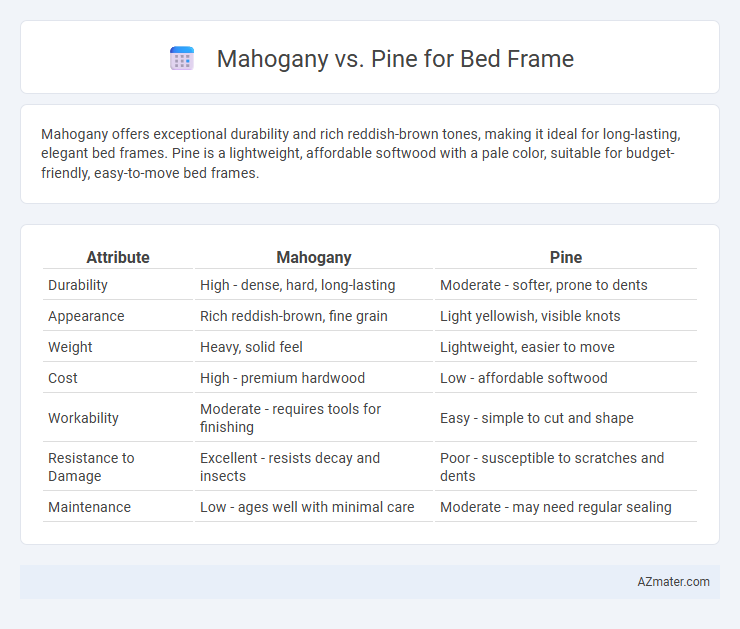Mahogany offers exceptional durability and rich reddish-brown tones, making it ideal for long-lasting, elegant bed frames. Pine is a lightweight, affordable softwood with a pale color, suitable for budget-friendly, easy-to-move bed frames.
Table of Comparison
| Attribute | Mahogany | Pine |
|---|---|---|
| Durability | High - dense, hard, long-lasting | Moderate - softer, prone to dents |
| Appearance | Rich reddish-brown, fine grain | Light yellowish, visible knots |
| Weight | Heavy, solid feel | Lightweight, easier to move |
| Cost | High - premium hardwood | Low - affordable softwood |
| Workability | Moderate - requires tools for finishing | Easy - simple to cut and shape |
| Resistance to Damage | Excellent - resists decay and insects | Poor - susceptible to scratches and dents |
| Maintenance | Low - ages well with minimal care | Moderate - may need regular sealing |
Introduction: Mahogany vs Pine for Bed Frames
Mahogany and pine are two popular wood choices for bed frames, each offering distinct characteristics in durability and appearance. Mahogany is prized for its rich color, dense grain, and long-lasting strength, making it a premium option for lasting furniture. Pine, being lighter and more affordable, provides a softer feel and easier customization, appealing to budget-conscious buyers and those seeking a rustic aesthetic.
Wood Characteristics: Mahogany and Pine Compared
Mahogany offers a dense, tightly-grained wood that is naturally resistant to rot and insect damage, providing durability and a rich, dark finish ideal for elegant bed frames. Pine, in contrast, features a lighter, softer texture with prominent knots and a pale yellowish hue, making it more affordable but less resistant to dents and scratches. The choice between mahogany and pine for bed frames largely depends on desired aesthetics, longevity, and budget constraints.
Durability and Strength: Which is Better?
Mahogany offers superior durability and strength compared to pine due to its dense hardwood composition, making it highly resistant to wear, scratches, and warping over time. Pine, being a softwood, is lighter and more prone to dents and damage but is easier to work with and more affordable. For a bed frame requiring long-term stability and robustness, mahogany is the better choice because of its enhanced structural integrity and longevity.
Aesthetic Appeal and Color Differences
Mahogany bed frames offer a rich, deep reddish-brown hue with natural grain patterns that enhance traditional and elegant bedroom aesthetics. Pine bed frames present a lighter, yellowish tone with knots and a more rustic, casual look that complements minimalist or cottage-style decor. Color stability in mahogany is higher, maintaining its warmth over time, whereas pine may yellow or darken with age, affecting long-term visual appeal.
Cost Comparison: Mahogany vs Pine
Mahogany bed frames typically cost significantly more than pine due to the hardwood's density, durability, and rich reddish-brown color, often priced between $800 to $1,500 for a standard queen size. Pine bed frames are more budget-friendly, commonly ranging from $150 to $400, as pine is a softer, more abundant wood that is easier and less expensive to source. The higher initial investment in mahogany often reflects its superior longevity and resistance to wear compared to pine's tendency to dent and scratch over time.
Sustainability and Environmental Impact
Mahogany, sourced primarily from slow-growing tropical hardwoods, often faces sustainability challenges due to deforestation and limited availability, whereas pine is a fast-growing softwood, making it a more renewable and environmentally friendly option for bed frames. Pine's rapid growth cycle allows for quicker replenishment in managed forests, reducing habitat disruption and carbon footprint compared to mahogany. Selecting pine over mahogany supports sustainable forestry practices and promotes lower environmental impact in bedroom furniture production.
Maintenance and Longevity
Mahogany bed frames offer exceptional durability and resistance to wear due to their dense, oily grain, requiring minimal maintenance beyond regular dusting and occasional polishing to preserve their rich color. Pine bed frames are softer and more prone to dents and scratches, demanding more frequent upkeep such as sanding and sealing to maintain structural integrity and appearance. Over time, mahogany outperforms pine in longevity, making it a superior choice for long-lasting bed frame construction.
Weight and Ease of Handling
Mahogany bed frames tend to be heavier due to the wood's dense, durable nature, providing stability but making handling and assembly more challenging. Pine is significantly lighter and easier to maneuver during setup, making it a preferred choice for those seeking more manageable furniture. Weight differences impact mobility and installation, with pine offering greater convenience while mahogany promises long-lasting robustness.
Suitability for Different Interior Styles
Mahogany bed frames suit traditional, classic, and luxurious interior styles due to their rich, deep color and fine grain, adding warmth and elegance to bedrooms. Pine bed frames, with their light color and rustic charm, complement Scandinavian, farmhouse, and casual interiors, offering a versatile and budget-friendly option. Both woods provide durable structures, but choosing mahogany or pine depends on the desired aesthetic and room ambiance.
Final Verdict: Choosing the Right Wood for Your Bed Frame
Mahogany offers exceptional durability and a rich, deep color that enhances the elegance of bed frames, making it ideal for those seeking luxury and long-lasting quality. Pine provides a budget-friendly, lightweight option with a natural, rustic charm, suitable for casual or DIY projects. The final verdict depends on balancing cost, aesthetic preference, and durability requirements, with mahogany favored for premium, heirloom-quality frames and pine chosen for affordability and ease of customization.

Infographic: Mahogany vs Pine for Bed Frame
 azmater.com
azmater.com